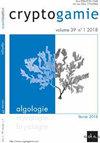海葵(Exaiptasia diaphana)与共生鞭毛藻(dinoflagellium spp)共生作用中的化学通讯。
IF 1.5
4区 生物学
Q3 MARINE & FRESHWATER BIOLOGY
引用次数: 0
摘要
摘要鞭毛藻Symbiodinium sp.与海葵Exaiptasia diaphana Rapp建立了共生关系。导致两个共生伙伴相互承认的过程仍然没有得到很好的理解。我们推测,在全共生和非共生共生的海葵之间,或者在自由生存的共生和全共生和非共生的海葵之间,化学信号相互交换,导致了共生海葵中有机和元素组成的变化。为了验证这些假设,将漂白的海葵暴露在自由生活的共生菌(以前从同一个Exaiptasia克隆中提取的共生菌)或全息生物的存在下。前医院藻类和全息生物被包括在透析膜中,截止时间为14000 Da。在对照处理中,实验样本暴露于空的透析管中。采用傅里叶变换红外光谱法和全反射x射线荧光光谱/气相色谱法分别测定了海葵的有机组成和元素组成。在没有任何明显的营养作用的情况下,实验的反共生海葵的有机和元素组成都与对照有显著差异,这一事实表明反共生海葵和全共生海葵之间交换了化学信号。本文章由计算机程序翻译,如有差异,请以英文原文为准。
Chemical Communication in the Symbiotic Interaction between the anemone Exaiptasia diaphana (ex Aiptasia pallida) Rapp and the Dinoflagellate Symbiodinium spp.
ABSTRACT The dinoflagellate Symbiodinium sp. establishes symbiotic relationships with the anemone Exaiptasia diaphana Rapp. The process that leads to the reciprocal recognition of the two symbiotic partners is still not very well understood. We hypothesize that chemical signals are exchanged between the Exaiptasia diaphana-Symbiodinium holosymbiont and aposymbiotic anemones or between free living Symbiodinium and holo- and aposymbiotic Exaiptasia, leading to changes in organic and elemental compositions in the aposymbiotic anemones. In order to test these hypotheses, bleached anemones were exposed to the presence of either free living Symbiodinium, previously extracted from the same Exaiptasia clone, or to holobionts. The ex-hospite algae and the holobionts were included in dialyses membranes with a cut-off of 14 000 Da. In the control treatments, the experimental samples were exposed to the presence of empty dialysis tubes. The organic composition and the elemental composition of the anemones were determined by Fourier Transform Infrared Spectroscopy and Total Reflection X-Ray Fluorescence Spectroscopy/Gas Chromatography, respectively. The fact that both the organic and elemental composition of the experimental aposymbiotic anemones differed significantly from the controls, in the absence of any obvious nutritional effect, is suggestive of an exchange of chemical signals between the aposymbiotic and holosymbiotic anemones.
求助全文
通过发布文献求助,成功后即可免费获取论文全文。
去求助
来源期刊

Cryptogamie Algologie
生物-海洋与淡水生物学
CiteScore
2.60
自引率
7.70%
发文量
11
审稿时长
>12 weeks
期刊介绍:
Cryptogamie is a fast-track and peer-reviewed journal of international scope publishing in English only. It accepts original papers and review articles on the taxonomy, biology and ecology of all cryptogams. An issue of Cryptogamie may be devoted to a single topic, under the responsibility of guest editor(s). All articles published in Cryptogamie are compliant with the different nomenclatural codes. A copyright assignment will be signed by the authors before publication.
Cryptogamie, Algologie accepts articles on systematics as well as ecology and evolution of any kind of algae (including Cyanobacteria).
 求助内容:
求助内容: 应助结果提醒方式:
应助结果提醒方式:


